




By Collette Hayes |

Shaped by years of hard work, dedication, and perseverance, 1,500 athletes and Unified Partners from nearly 100 nations united in Turin, Italy, to compete in the Special Olympics World Winter Games Turin 2025. Four athletes representing the United States in DanceSport took center stage during game events, celebrating their remarkable journey to winning gold and bronze medals. Thousands watched in silence as the U.S. national anthem filled the Stadio Olimpico Grande Torino event center, and the American flag was raised in honor of the U.S. athletes.
The athletes are team members of the Salt Lake Stars, a Special Olympics Utah team participating in the Metro (SLC) region. Last year, these four athletes achieved gold medal finishes in the Utah dance program, qualifying them for international competition. They were the only dancers selected to represent the USA at the World Games and were the first to compete internationally.

According to Special Olympics International Board of Directors, DanceSport combines dance and athletic competition elements. Athletes perform choreography to music, which may include a variety of dance styles such as ballet, modern dance, hip-hop and others.
Cottonwood Heights resident Andy Melville, Saratoga Springs resident Nora Schultz and South Jordan residents Trey Garett and Natalie Green returned home during the week of March 16 from Turin, where they were greeted by cheers and banners celebrating their remarkable win in DanceSport performance at the 2025 World Games.
















TMS is like physical therapy for the brain. It uses magnetic pulses, similar in strength to MRI, to reignite dormant connections in the brain and give you control of your depression. With NeuroStar, you can live on your terms. Our Psychiatrist is available now, don’t wait to get help.
“I had taken 11 different medications without any relief… NeuroStar treatment has helped me bring my life back… with a happiness that I’ve never experienced before” ~TODD





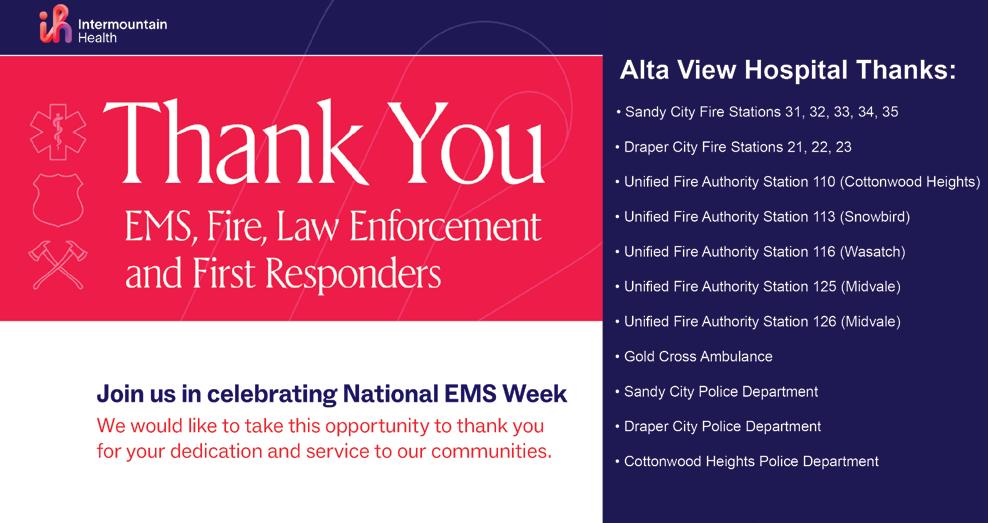
Andy Melville has been studying dance at the University of Utah Tanner Dance studio for 18 years and recently at the Infinity Dance Studio in Ogden where he prepared for the 2025 World Games.
According to Andy’s mother, Yukie Melville, Andy shines when he has an audience—the larger the better. He’s performed at half-time shows at BYU football games and in the Tabernacle Choir on Temple Square’s Christmas Specials, also winning the lead in the Tanner Dance production of “Finding Nemo Jr.”
“Definitely, winning a gold medal in Turin has been the highlight of Andy’s dance career,” Yukie Melville said. “Andy works for Granite School District Food Services and he had to ask for two weeks leave to participate in the games. They were more than willing to let him take the time off.”
Holladay Mayor Rob Dahle welcomed the Special Olympic athletes to City Hall in March. He asked Andy Melville if he were going to continue his rigorous dance workout schedule now that he was home from Turin. “No,” Andy Melville said without hesitation, “I need to get back to work.”
Schultz brought home the gold winning in a DanceSport solo performance. She has participated in numerous sports with Special Olympics since joining in 2022.
According to Special Olympics USA, Schultz says Special Olympics has helped her to stay active and improve her social skills. In addition to her rigorous athletic training schedule, she attends Brigham Young University, holds a part-time job and helps to teach a weekly Sunday school class.
Garett and Green, who performed in the duo dance competition, told the Journal going out at night with family and friends
to experience Italian cuisine was a highlight during the games.
“The pastas, croissants and different kinds of pizza in Italy are amazing,” Green said.
Pin Trading
Pin collecting was a popular activity during the World Games for the athletes. Prior to the games, an art contest was held, and Green’s design was chosen to become the official Olympic DanceSport sticker for the Special Olympics North America team. This sticker is showcased on the Olympic pin and was given to the athletes to commemorate the World Games. Green’s artwork has also been featured on T-shirts and even socks. In collaboration with a family friend, her plans are to create more art designs for socks and continue contributing her art to various charitable events
“In Italy, Trey and I competed against each other collecting pins. He beat me!” Green said as she smiled and laughed. “Trey collected 50 pins - I only collected 37. It was so fun pin trading with athletes from different countries.”
Before leaving for Turin, Green ended up getting a job at Lucky One’s Coffee at the Maramalade branch of the Salt Lake City Public Library.
“Lucky One’s a coffee shop that is LGBTQ friendly and woman owned,” Green said, “and they hire those that have intellectual and physical disabilities. They are located in Park City and now at Marmalade Hill. I’ve been practicing for my new job. I made my dad his first latte ever with a side of avocado toast. He said it was great! My first day on the job will be this Saturday. I’m definitely going to be everyone’s favorite barista!”
What do these athletes enjoy most about dance?
Andy Melville enjoyed working collaboratively with his coach to prepare to compete. He selected his dance music “The Color of the Wind” and helped to choreo-
graph the contemporary dance performance. Garett enjoys the beat of the music and the feeling the music provides when he dances. “When I was training, I had to go to bed early, wake up early and train a lot and then do it all over again. It was worth it because I liked being a part of something greater than me.”
Green said it makes her happy inside when she can share dance with an audience and especially with the people she loves. The coach’s role in supporting the athletes
Special Olympics coach Judy Hut makes sure athletes are physically and mentally prepared for state tournaments.
“Special Olympics athletes compete in sports seasons that last 10 to 12 weeks,” Hut said. “The most rewarding aspect of coaching is to see athletes who are often overlooked shine on stage, the court, and the playing field. It brings me so much joy to see an athlete exceed expectations and achieve a personal goal. The most challenging aspect is juggling my day job with volunteer work.”
When the U.S. DanceSport team arrived in Turin there were obstacles and challenges to overcome mixed with incredible highlights.
“On the day the judges reviewed routines, we were told that Natalie had to perform the same floor move as her partner Trey, a move that her choreographer Brooke had originally taken out because of Nat's limited mobility on her left side. It was a shock and a setback, as Nat was supposed to go in front of the judges to be placed in a division for finals just 48 hours later,” Hut said.
“Nat was upset and worried, and we all were, which was 100% justified,” Hut continued. “The routine she had practiced for four months now needed to be changed and the floor element brought back. But Nat did what she does best, demonstrating her resiliency and optimism. She got back up
again to persevere and nail the choreography. She and Trey were placed in the highest duo division and ultimately took home the bronze. Other highlights were watching Andy and Nora nail their routines, both earning gold in their respective routines. It was an honor to see these amazing athletes represent Utah and the USA on a global stage. They gave incredible performances and showed the world their heart, dedication, and passion.”
Mayor Dahle thanked the athletes and their parents for their hard work and for representing the U.S. at the 2025 World Games.
“To all of the parents here, you have very special children,” Dahle said, “I can tell how much work you have put into supporting them in their passion. It’s so impressive.”
In the written words of Special Olympics International, “Visiting any of the venues during the games, you would see it firsthand—high fives, fist bumps, and energetic crowds. The sportsmanship at Special Olympics was extraordinary.”
The Special Olympics World Games theme of "the Strength of Kindness" was a hallmark characteristic demonstrated at all times in the four US athletes as they represented the United States in Turin. When the American flag flies, it symbolizes freedom, democracy, and unity for all.
“Special Olympics means everyone gets the opportunity to do what they love,” Green said. “In the words of the Special Olympics founder Eunice Shriver, I think it's true that everyone with a physical or intellectual disability deserves to have a seat at the table. This really matters to me. As DanceSport athletes, we are really showing the world what inclusion looks like and what it means to lead from the heart. As dancers, we have come a long way in life.” l
COTTONWOOD HEIGHTS TEAM
The Cottonwood Heights Journal is a monthly publication distributed directly to residents via the USPS as well as locations throughout Cottonwood Heights.
For information about distribution please email hello@thecityjournals.com or call our offices. Rack locations are also available on our website. The views and opinions expressed in display advertisements do not necessarily reflect or represent the views and opinions held by Loyal Perch Media or the City Journals. This publication may not be reproduced in whole or in part without the express written consent of the owner. © 2019 Loyal Perch Media, Inc.
PUBLISHER
Bryan Scott | bryan.s@thecityjournals.com
EDITOR
Travis Barton | travis.b@thecityjournals.com
ADVERTISING EXECUTIVES
Mieka Sawatzki | mieka.s@thecityjournals.com
Lindsay Andreasen | lindsay.a@thecityjournals.com
Jason Corbridge | jason.c@thecityjournals.com
Ryan Casper | ryan.c@thecityjournals.com
Marc Davis | marc.d@thecityjournals.com
Lydia Rice | lydia.r@thecityjournals.com 385-557-1022
Rack locations are also available on our website.
EDITORIAL & AD DESIGN
Anna Pro Ty Gorton Stacey LaMont

COTTONWOOD HEIGHTS CITY JOURNAL 9500 South 500 West, Suite 205 Sandy, UT 84070
PHONE: 801-254-5974
Students take concepts and apply them with business pitches to community judges.
By Julie Slama j.slama@mycityjournals.com
Natural dog topping, a décor app, musical sleep mask, fresh pasta meals, a lit-up toilet, shoe covers, a positive-affirmation mirror and a swimming watch were amongst the 180 product pitches by 250 sixth graders in Butler Middle School’s first-ever Shark Tank.
The event wasn't just about presenting a product idea. Students had to identify their target market, calculate production costs, and determine a selling price that would generate a profit. They conducted competitor research, highlighted their product’s uniqueness, figured out the necessary startup capital, and chose the best places to sell their products. They then presented their products to judges, answering questions and being evaluated on their knowledge, advertising strategies, prototypes, presentations and more.
One of the students, Bea Minton, had recently moved to Utah from Alabama and pitched her product called Long Doh.
“I love playing with Play Doh, but I'll play with it one time, and then, a few days later, it’s hard,” Bea said. “I want to be able to play with it as long as I want to. So, I looked at a lot of different ideas of what people have done in this past, and I put all of those together to make a nontoxic mix because a lot of them had harmful chemicals in them. When I saw that, it was weird for me, because why not just make it out of natural things? So, I put together all the natural things together and it has stayed soft.”
It took Bea about a week to achieve the right consistency for her Long Doh prototype.
“I learned to not give up, sometimes it's hard to figure out all the different things, but I wanted to keep going,” she said.
After developing the prototype, Bea worked on her business plan, using guidance from her college and career awareness teacher, Missy Hamilton, and practiced her presentation.
“This is my first business proposal; I liked learning what all is involved,” she said. “I want to be my own business owner and open my own restaurant one day.”
After a two-hour final round of presentations, Bea took first place, followed by classmate Max McNall with the Ski Brake Buddy in second place. Vivienne Durand’s Smoosher Moosher trash compactor was third, Harper Halverson’s Pack Perfect cosmetics was fourth, and Marcus Jensen’s Purple Platypus Custom Cocoa was fifth. The top presenters received trophy night lights, made in the school’s MakerSpace.
The event was part of the students’ business and marketing unit in their career cluster.
“The students learned about marketing, they put together a business plan, they came up with the idea and created a prototype, they figured out the financials of how much it cost to build one, how much they wanted to sell it for, and what the retail price was going to be. They had to research their competitors. They had to figure out if they were going to have employees and how they could afford to pay them and provide them with health insurance and other benefits,” Hamilton said about the monthlong project. “It was eye-opening for them. They learned the concepts and applied them. I wanted to have this be relevant, but this even exceeded my expectations.”
The Shark Tank event wasn’t just about business and marketing skills, though.
“It’s part of learning how to communicate, getting ideas across, problem solving. It’s those soft skills we have to learn in our lifetime and what better way to do it than doing it in a public presentation with something they have a passion or enjoy?” Hamilton said. “The best part was seeing kids who don't normally get to shine. Some kids lit it on fire. Not every unit we study speaks to every kid, but some units do. So, it was really fun to see them find their passion and find their place with this one.”
Hamilton also appreciated the help she received from Sydney Pierce, Cottonwood Heights' business development specialist, who arranged volunteer judges.
“It was great to be able to partner with businesses, business community members and local elected officials with this project. I had some directed questions for the judges, but then they took off. They understood the assignment and came up with their own relevant questions on the students’ level and understanding. It was great that the preliminary and finals judges gave so much of their time and commitment to this Shark Tank,” she said.
Principal Bryan Rudes said many parents attended the event to support their children during the preliminary and final rounds.
“I love it gave the opportunity for families to come in and for us to highlight what their students are doing,” he said. “It really gave a visual to what's going on here, the teaching Missy is doing day in and day out.”
The course curriculum also includes agriculture, manufacturing, transportation, distribution and logistics, engineering and technology, cosmetology, tourism, arts, audiovisual tech and communication, law, public safety, corrections and security and health.
Hamilton said the Shark Tank event serves as a springboard for the rest of the
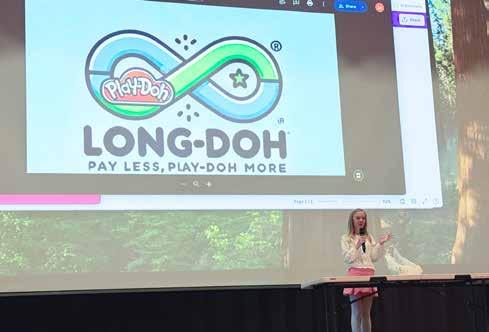
Sixth-grader Bea Minton pitched her product, Long Doh, at Butler Middle School’s first-ever Shark Tank. (Julie Slama/City Journals)
finance unit.
“We're going to take this experience, and launch into personal finance — checking and savings,” she said. “We're going to play a stock market game. It will give us a baseline of how to be smart in our economy.”
For Bea, the experience was about more than just business and communication skills.
“The best part of it has been meeting all the other people who are doing this,” she said. “I’ve been making better relationships and cheering them on.”l






Canyons School District provides help for anxiety, depression and other mental health issues.
By Julie Slama j.slama@mycityjournals.com
Excessive worry, loss of interest in activities, fatigue, difficulty concentrating, and other symptoms can signal anxiety or depression in students — and they are not facing these challenges alone.
In Canyons School District, more than 200 students are receiving support at any given time, according to Nicole Svee Magann, district student wellness services assistant director.
“We’re seeing kids struggling with how to resolve conflict; they're struggling with peer interaction,” she said. “We need to teach how we communicate and resolve problems in a kind and empathetic manner and how to navigate the world in a safe, kind way. We are deeply committed to helping these students succeed and ensuring they have the emotional support they need to thrive in healthy learning environments.”
All students receive some form of support, including the district's own social-emotional curriculum, Thrive Time, which was introduced this year in kindergarten through eighth-grade classes, according to Brian McGill, district student wellness services director.
“The curriculum is focused on helping kids create self-awareness and respecting themselves and respecting others through building self-esteem, building healthy relationships with other students, communicating and understanding their community,” he said.
The curriculum also helps students set both academic and career goals, while teaching them healthy conflict resolution skills.
At the high school level, students involved in the quarterly High School Leadership Academy learn strategies related to adversity, resilience and collaboration. They also create action plans to implement these strategies in their schools, guided by advisers.
“Plus, our wellness team has lessons on things like resilience, grit, motivation and those metacognitive lessons,” he said.
McGill suggests parents pay attention to their students' mental health, considering not just their stress levels and peer influences but also their nutrition, sleep, physical activity and other factors which contribute to well-being. He emphasized the importance of discussing mental health in a safe space and offering patience and support.
While all students benefit from pre-
ventative supports, additional resources are available for students who need help addressing challenges or accelerating their success.
When mental health concerns arise, both McGill and Svee Magann recommend reaching out to the school counselor or social worker for guidance. After the initial visit, parents must sign a FERPA consent form, as required by law.
In elementary schools, there is typically one counselor or social worker; in middle schools, there are two to three counselors; and high schools employ six to eight counselors, along with social workers and a school psychologist.
“All schools have a school student support team when they see students struggling, to help build support for those students,” Svee Magann said. “We also have a district support team with psychologists and others to provide additional kinds of support. Then, we can reach out to the community to connect students with those who do actual therapy; what we do is more related with school skills.”
The district partners with several contracted agencies to help students, with Project Connections and Hopeful Beginnings being the most common.
“If we see a student with significant issues who needs ongoing support and therapy, then we can bring them to the table, if the students and parents are interested,” he said.
In addition, the district offers seven free mental health screenings each year. Students complete a Terrace Metric Survey, which assesses mental health issues such as anxiety, depression and stress.
In the 2023-24 school year, 125 students participated in these screenings, and the number is expected to remain the same this year, said Kelly Redican, the district’s prevention specialist. She added about 30% of those students screened required mental health assistance.
“We have a lot of behavioral issues in our schools at higher volumes than we've ever seen,” McGill said. “It's a culmination of things. COVID certainly had an impact on all of us, but it’s a whole host of reasons — the challenges that come in some homes with economic disparity, split homes, kids being neglected, being abused, having difficult home lives, all of that, obviously can contribute to behaviors in school. And school is the end-all catch-all source to solve the child's problems.”
He drew a comparison to Maslow's hierarchy of needs.
“Schools and school districts are being more required to try to help support some of those fundamental needs so that we can get them to a place where they can prioritize
Here are some options for students seeking support.
1. School counselor or social worker— Reach out to get guidance and support navigating through challenges.
2. Canyons Family Center — Get information for individualized counseling, classes, screenings and resources — (www.canyonsdistrict.org/depts/student-wellness-services/canyons-family-center/) or Student Wellness Services (801) 826-5416 or (www. canyonsdistrict.org/depts/student-wellness-services/).
3. For immediate help in crisis situations— download and use the SafeUT app for confidential chat and tips on mental health or reach out to the National Suicide Prevention Lifeline by calling or texting 988.
their learning, because if they don't have a lot of those basic needs met, then learning in school comes secondary. Because nine times out of 10, if kids are projecting behavior at school, there's a need that's either not being met outside of school, and then we need to provide an analysis and support for both the child the parents, and if needed, get them hooked up with resources to help,” McGill said.
Additionally, Canyons Family Center provides individual counseling, student support groups, and educational classes, including teen self-esteem, anger management, emotional intelligence, substance abuse prevention, a divorce class for kids and parenting strategies for students with ADHD. Additional support services are available for grief counseling, suicide prevention, physical aggression and other needs. The center also can connect families with community resources for mental health treatment.
In the 2023-24 school year, Canyons Family Center completed 30 intakes and 12 short-term counseling sessions and they are on track to surpass those numbers in 2024-25, with 40 intakes expected by midMay, Redican said.
She also said two classes — Anger Management and Substance Abuse — serve more than 600 students and their parents or guardians each year.
A new initiative this year is the IHC
telehealth pilot, offered at 17 schools. This allows students to get screened at school and arrange for prescriptions to be picked up by parents. The service helps students remain at school while receiving necessary medical attention, with equipment and services donated by IHC. It is expected to expand to more schools in the 2025-26 school year.
“We've had such success with it, in keeping kids in school and working with parents who are checking of the well-being of their children at school. It becomes a time savings for parents as they don’t have to take their children to a doctor and to a pharmacy as well as a cost savings as the service is being offered free,” he said, adding that it’s also available for all employees.
Canyons’ nursing team also is an integral part of the wellness team.
“The school nurses play a very vital role in the schools as it relates to the physical health and well-being and the welfare of the child, which oftentimes can reflect in mental health and vice versa,” McGill said. “We talk about mental health, but really, it’s part of this umbrella of health in general, of the student’s welfare and wellness. Our No. 1 focus and goal is to provide wellness supports to students in school so they can focus on their learning. We want them to be safe, be healthy and ready to learn.” l
City officials were especially interested in how the housing bills panned out.
By Cassie Goff c.goff@mycityjournals.com
“Itwas wild and crazy the last couple of weeks,” said Brian Allen, principal lobbyist for Cottonwood Heights.
Allen was joined by Executive Assistant Chantel Nate and lobbyist Greg Curtis to provide a Legislative Recap Report on the 2025 General Session to the Cottonwood Heights City Council and staff members March 18.
As the council has been in numerous conversations about housing affordability within the city throughout the years, they were especially interested in hearing about how the housing bills panned out.
HB 256: Municipal and County Zoning Amendments, sponsored by Rep. Neil Walter and Sen. Evan Vickers, was signed March 19. This bill attempts to define and modify authority related to short-term rentals. Allen reported that now cities will be able to look at vacation rental listing websites to report nonbinding listings that are noncompliant.
“It ended up not as strong as we’d hoped but better than we thought,” he said.
SB 23: First Home Investment Zone Amendments sponsored by Sen. Wayne Harper and Rep. Stephen Whyte was signed March 26. This bill makes changes to median home pricing ratings and extraterritorial home definitions within first home investment zones.
SB 262: Housing Affordability Modifications sponsored by Sen. Lincoln Fillmore and Rep. Whyte was signed March 27. This bill makes changes to the Utah Housing Corporation and home ownership zone funds for municipality use regarding water exaction, street lighting and environmental costs.
Allen reported that both HB 360 and HB 368 (below) were supported by the Utah League of Cities and Towns.
HB 368: Local Land Use Amendments sponsored by Rep. Whyte and Sen. Fillmore was moved to the governor’s office March 17. This bill modifies provisions related to municipal land use including floor plans, landscaping and deeds.
HB 360: Housing Attainability Amendments sponsored by Rep. Whyte and Sen. Fillmore was signed March 26. This bill is entirely related to affordable housing regulations through numerous state housing programs.
HB 58: Building Inspector Amendments, sponsored by Rep. Thomas Peterson and Sen. Calvin Musselman, was signed March 19. This bill alters amendments for building inspections and licensing.
“For rural cities it would have been a real challenge to comply with the original
bill,” Allen said. “We got it down to a much more reasonable place by amending it down to home examining."
Allen tentatively reported on two of the more controversial bills of the session and discussed how the city needs to move forward to be in compliance with the new laws.
HB 77: Flag Display Amendments sponsored by Rep. Trevor Lee and Sen. Daniel McCay passed into law March 27 without the governor’s signature. This bill prohibits certain flags to be displayed on government property.
“You can fly flags of other nations for historical or informational purposes, like in a classroom. But it prohibits some other things...it targets other flags, really,” Allen said.
Allen did note the lack of “teeth” within this bill to the city councilmembers. If there is a violation, it must be “cured” within 30 days. Otherwise, no specific punishment or violation is listed.
SB 277: Government Records Management Amendments, sponsored by Sen. Michael McKell and Rep. Jefferson Moss, was signed March 27. This bill replaces the State Records Committee with the director of the Government Records Office. Allen told the city council that this bill doesn’t change the process for accessing records.
“The good news about this is it will speed up the process,” he said. “A full-time trained law person will be reviewing records requests every day. In the long run, I think it will be a faster, quicker, cheaper process.”
Cottonwood Heights will likely see an increase to their tax revenue funds thanks to the passing of two separate house bills.
HB 456: Transient Room Tax Amendments, sponsored by Rep. Bridger Bolinder and Sen. Vickers, was signed March 25. This bill creates an Outdoor Recreation Mitigation Grant Program and modifies acceptable uses of transient room tax revenue for municipalities.
“It gives us an opportunity to work with the county and raises the tax,” Allen said.
HB 502: Transportation and Infrastructure Funding Amendments, sponsored by Rep. Teuscher and Sen. Kirk Cullimore, was signed March 27. This bill allocates funds for counties and transportation projects.
“The $20 million set aside for the transit hub at the mouth of Big Cottonwood Canyon changed to a percentage of taxing to grow with the economy and overall community,” Curtis said.
Another bill that might have a financial impact on the city relates to the authority and ownership of gravel pits — especially as the Big Cottonwood Canyon Gravel Pit development is underway.
HB 355: Mining and Critical Infrastructure Materials Amendments, sponsored by Rep. Casey Snider and Sen. Scott Sandall, was signed March 26. This bill clarifies how

a gravel pit can expand into land they currently own.
“I think there’s work to be done still between cities and gravel pits,” Allen said. “We had a lot of fun with Rep. Snyder on this bill. It was better in the end but it’s still not in a perfect place.”
Allen and Nate mentioned a few lasting bills that may have more minimal impact to the city’s leadership and residents in the year to come.
SB 195: Transportation Amendments, sponsored by Sen. Wayne Harper and Rep. Kay Christofferson, moved to the governor’s office March 13. This bill clarifies connectivity planning for who has responsibility for maintaining street lighting. Cities have to maintain decorative lighting on state highways.
“This targeted Salt Lake City and their traffic education strategies,” Allen said.
SB 340: Protected Person Amendments, sponsored by Sen. Don Ipson and Rep. Tyler Clancy, was signed March 25. This bill provides opportunity to obtain a certificate to bypass municipal codes for security measures when there’s a credible threat against life or safety. Allen had speculated this bill was written to accommodate a celebrity.
“It was for someone who has a lot of money,” corrected Cottonwood Heights Mayor Mike Weichers.
HB 40: School Safety Amendments, sponsored by Rep. Ryan Wilcox and Sen. Ann Millner, was passed to the governor’s office March 17. This bill modifies communication requirements and administrative structures relative to school safety programs. It takes some of the “burden” off of local law enforcement, even though it requires coordinating with the county. Allen noted how it was the seventh substitute of this bill that was passed.
“That’s how many times it went back and forth,” he said. “I think that’s a good win.”
SB 328: Alcohol Amendments, sponsored by Sen. Jerry Stevenson and Rep. Karen Peterson, was signed March 24. This bill prohibits alcohol in local parks and playgrounds. It also addresses alcohol allowances in amphitheaters and venues.
Allen laughed at the process of this bill — thinking it had died earlier in the session but then came back. “There was a Lazarus effect.”
SB 179: Local Regulation of Business Entities Amendments sponsored by Sen. Calvin Musselman and Rep. Karen Peterson was signed March 19. This bill will require Cottonwood Heights, and all municipalities, to enact a land use regulation establishing a process for reviewing a business use not already listed in existing ordinances.
HB 504: Financial and Conflict of Interest Disclosures by Candidates Amendments, sponsored by Rep. Lisa Shepherd and Sen. Ronald Winterton, was signed March 24. This bill amends deadlines and requirements for conflict of interest disclosure statement for running candidates.
HB 198: Highway Expansion Impacts on Signage Amendments, sponsored by Rep. Val Peterson and Sen. John Johnson, was signed March 26. Allen summarized how this bill allows a billboard to move, if highway expansion forces it to come down, anywhere along the same roadway in the same city. If the city can’t work out a new agreement location for the billboard, then the city has to pay for it.
HB 364: Governmental Immunity Amendments, sponsored by Rep. Kay Christofferson and Sen. Todd Weiler, would provide governmental immunity to law firms.
“It will come back next year,” Allen said. “It died by the clock on the last day.” l
Hillcrest Special Olympian embraces every opportunity in his journey of resilience and inclusion.
By Julie Slama j.slama@mycityjournals.com
Area high schools are preparing for their commencement ceremonies in May and June and many high school seniors are eager to leave their classrooms to step into the workforce or continue their education and training.
While some students balance their schoolwork with part-time jobs or extracurricular activities the last few weeks, Hillcrest High senior Etiennemichel Camis-Bateman is fully immersing himself in everything his school has to offer.
Camis-Bateman is involved in cross country and track, cheerleading, the swim team, the school musical and the career club. In addition, he’s a Special Olympian, participating in Hillcrest's unified soccer and basketball teams, as well as competing individually.
“He was born eight weeks premature in South Africa; I was told by doctors he wouldn’t survive,” said his mother, Michelle Camis, who named her son after a Paris cathedral. “Etiennemichel has had every diagnosis in the world, and we still don't know what all he has; and it doesn't matter. He’s making up for lost time.”
Camis explained in South Africa, where they lived, there were no special education options available to him after fourth grade, so she homeschooled him. When they moved to St. George for a few months, everything changed for her son.
“A lot of doors opened for him when we moved here. We couldn't believe he could go to school, he could eat in the lunchroom with other kids, he could be in Scouts, that there were no restrictions. He went to an arcade, he learned to drive a bumper car, he learned to swim, to ride a bike. Every week, another door opened,” Camis said.
After briefly attending Olympus High, Camis-Bateman found his home at Hillcrest, where he has taken a range of classes, from theater to guitar.
“He first went out for cross country then he went to a school dance. He started going to football games. When he got to the game, the kids started giving him high-fives and hugging him; I felt like crying. They welcomed him instead of pushing him out. He has never had a single day of discrimination at Hillcrest. He goes to softball, lacrosse, basketball — every sport, almost every game,” she said.
Camis-Bateman is equally dedicated to his sports, often relying on rides from senior student body president Jack McDonough for practices.
“Etienne’s always super positive and in a great mood; he’s always saying we’re going to win and telling teammates that he’ll cheer for them in their races,” said McDonough, who said Camis-Bateman always is excited when his teammates do well. “He gets excited to compete; when Etienne trains or competes, he does it with great dedication and a great attitude. It’s always fun to cheer him on.”
Camis-Bateman’s enthusiasm for supporting others extended to his role as a cheerleader. Initially, his mother was unsure about him trying out for the squad.
“He's not flexible; he is not coordinated. He cannot do the splits or a back flip,” she said, adding she expected he’d get a shirt and pom poms and just cheer alongside the team. “I was told, ‘No, it’s not going to go like that. He’s part of the team.’ To their credit, they’ve treated Etiennemichel as a member like the others; he got the Husky Heart Award for his school spirit. That was huge for him.”
Assistant Principal Andrew Yawn remembers the unfor-
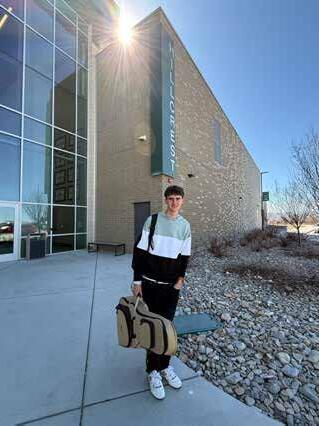
It may be the end of a school day at Hillcrest High, but senior Etiennemichel Camis-Bateman fills his afternoons and evenings by both participating in and cheering his peers on in extracurricular activities. (Julie Slama/City Journals)
gettable moment during senior night for the cheerleaders at a basketball game.
“Etiennemichel came out for his senior night, and it was the loudest cheer,” Yawn said. “He's a super nice kid. He goes out of his way to say hi and give me a high-five. He makes friends easily and the kids love him. He’s accepted. Hillcrest is a good community for everyone. I'm sure if he could, Etiennemichel would do every sport and every activity here if there was enough time.”
Recently, Camis-Bateman has added even more activities to his list. During job shadow day, he visited the legislature, where he spoke with lawmakers about restrictions faced by people with disabilities. Camis-Bateman also shared he is registered to vote.
Outside of school, he played Charlie in a local production of “Willy Wonka Jr.” and has earned 30 athletic medals, including one from the St. George triathlon. Now, he’s preparing to run the Salt Lake half-marathon.
“I want to give it a try,” Camis-Bateman said. “I like running.”
Additionally, he volunteers training Golden Retrievers to assist people in need of emotional or physical support.
“I want people to be happy, to be with the dogs, to be loved, to have a friend,” Camis-Bateman said. “I want to work with animals. I want to be a veterinarian assistant.”
With just a few weeks left before graduation, Camis-Bateman isn’t finished yet. He is submitting a film for the school district film festival about his experiences with differing abilities both in South Africa and the United States. He is also planning to audition to speak at graduation, which falls just four days after his birthday.
“It’s something I want to do,” Camis-Bateman said. “I want people to know what the school means to me.”l
Many area secondary schools are hosting commencement ceremonies this month and June. Here are some local graduations details. For more information, contact the schools.
Alta High – 2:30 p.m., May 29, at Utah Valley University’s UCCU Events Center in Orem.
Academy of Math, Engineering and Science — 3 p.m., May 29 at Cottonwood High School’s auditorium.
American Academy of Innovation — 6 p.m., May 28 at Viridian Event Center in West Jordan.
American Preparatory Academy — 2 p.m., June 7 on the school campus.
Beehive Science & Technology Academy — 7 p.m., May 22 at Salt Lake Community College’s Jordan Campus in West Jordan.
Bingham High — 8:30 a.m., June 4 at Utah Valley University’s UCCU Events Center.
Brighton High — 6 p.m., May 29 at the Maverik Center in West Valley City.
Corner Canyon High – 10 a.m., May 29 at Utah Valley University’s UCCU Events Center.
Cottonwood High — 2 p.m., May 28 at the University of Utah’s Huntsman Center in Salt Lake City.
Diamond Ridge High – May 28, Alta High’s Performing Arts Center in Sandy; time yet to be announced.
Entrada High – 7 p.m., June 12 at Alta High’s Performing Arts Center.
Hillcrest High – 2 p.m., May 29 at the Maverik Center.
Jordan High – 9:30 a.m., May 29 at the Maverik Center.
Jordan Valley – 3 p.m., May 23 in the school multipurpose room.
Juan Diego Catholic High — 9 a.m., May 24 in the school’s auditorium.
Life Skills Academy – noon, May 28 at the school’s auditorium.
Murray High — 11 a.m., June 5 at the Salt Lake Community College’s Lifetime Activities Center on the Redwood Campus in Taylorsville.
Paradigm High — 4 p.m., May 29 at University of Utah’s Kingsbury Hall in Salt Lake City.
River’s Edge — 1:30 p.m., June 6 at the school’s auditorium.
Valley High — 9 a.m., June 3 at Salt Lake Academy’s Zions Bank Stadium in Herriman.
Waterford School — 7:30 p.m., June 5 on the school campus.
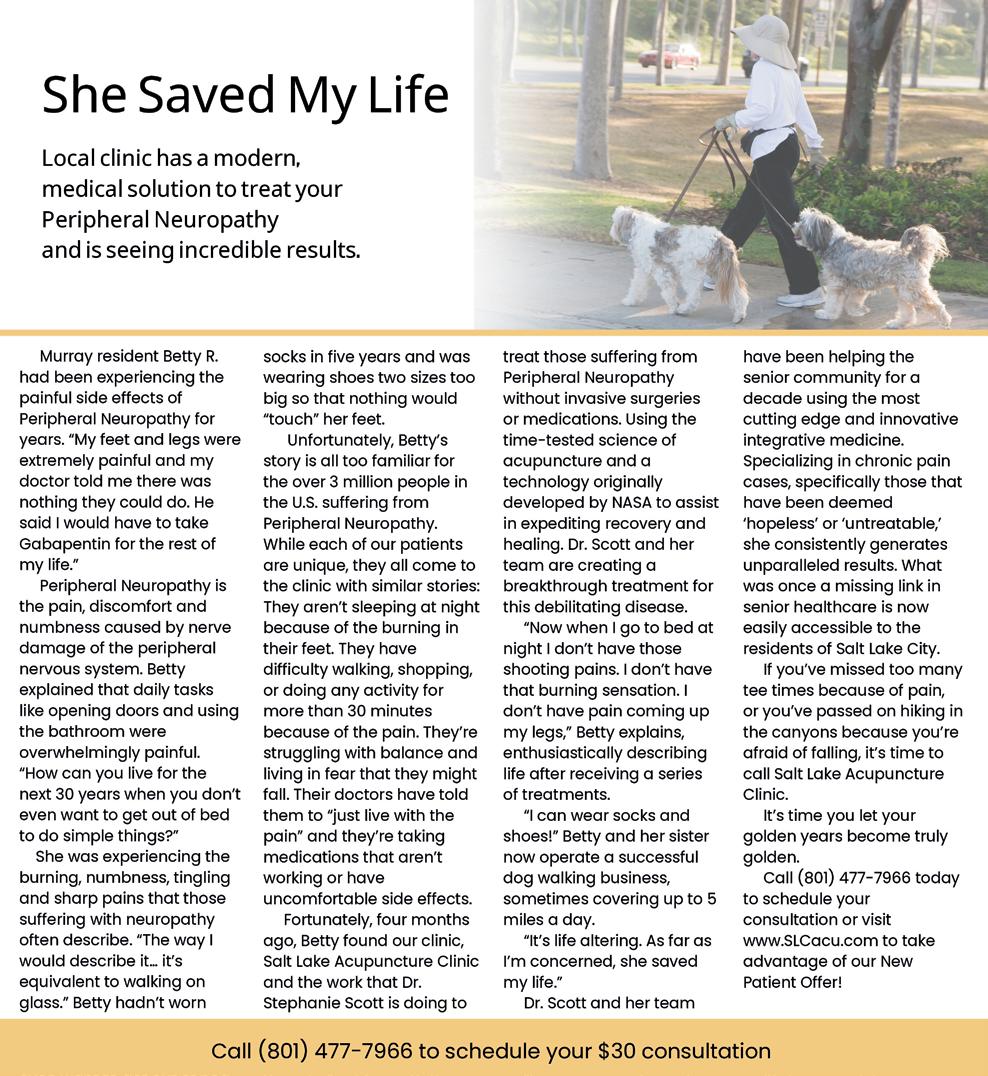
By Dr. Rebecca Reiser
We know how important it is for patients and their families to find a hospital and a care team that you can trust - especially when emergencies, like stroke, happen. That’s why our team at CommonSpirit Holy Cross Hospital – Jordan Valley is so incredibly proud to be a certified primary stroke center with thrombectomy capability. Recently, our stroke care team was recognized by the American Heart Association and received their Get with the Guidelines Gold Plus Award with Stroke Honor Roll and Type 2 Diabetes Honor Roll.
This award means our facility met or exceeded the national recommendations for stroke care for our patients and it highlights our hard-working, talented stroke care team for providing excellent patient stroke care!
To start, we work closely with our EMS partners to help them recognize patient stroke symptoms while they are out in the field. They are trained to let us know when they are on their way to our hospital so we can be ready for stroke patients before they even arrive. Our team is then able to evaluate each patient quickly and thoroughly to determine the best course of treatment. We have medications to help break up blood clots in the brain and a team of highly
trained vascular neurosurgeons who can remove a blood clot from the brain, also known as a thrombectomy. An important note - Holy Cross Hospital - Jordan Valley is the only hospital on the west side of the valley that has the capability of performing these state-of-the-art thrombectomies!
So, what are the signs and symptoms of stroke that you should be aware of? The easiest way to remember what to look out for is through the acronym, BEFAST:
● Balance changes
● Eye or vision changes
● Facial droop
● Arm weakness
● Speech difficulty
● Time

reduces disability among stroke survivors by 4%! That’s because about 2 million brain cells die every minute during a stroke until blood flow is restored. It is important that if you see someone showing the signs or symptoms of stroke outlined above, call for help immediately.
When you or your loved ones come to Holy Cross Hospital – Jordan Valley for stroke care, you can expect state-of-theart stroke treatment and compassionate, healing care fueled by humankindness. From the teams in the ER to the stroke care teams to the physical, occupational and speech therapists that help care for patients throughout their rehab journey, and to the neurologists that assist in care decisions from the start, you are in good hands at Holy Cross Hospital – Jordan Valley!

At CommonSpirit Health, we make the healing presence of God known in our world by improving the health of the people we serve, especially those who are vulnerable, while we advance social justice for all.
It is important to recognize the above signs and symptoms because time matters!
Stroke is the fourth leading cause of death in the United States, but it is the leading cause of long-term disability. Studies show that every 15 minutes saved when a patient is experiencing stroke symptoms,
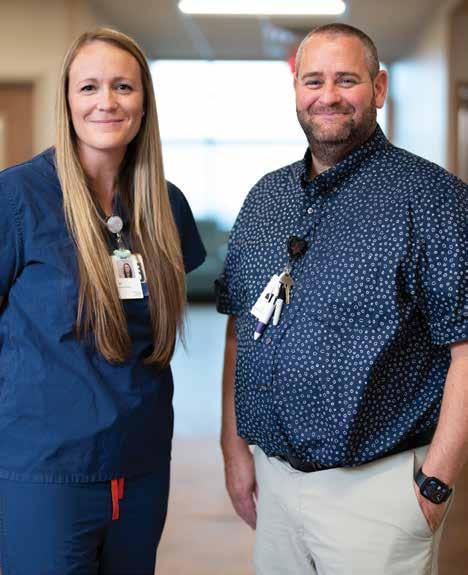
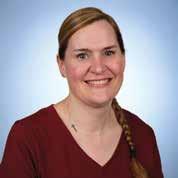

When you need emergency care fast, the closest emergency room is a smart thing to know. You never know the level of care you’ll need when an emergency happens and choosing the right ER can make all the difference. And a hospital ER comes with the confidence of additional services right on-site.


By Julie Slama | j.slama@mycityjournals.com
Through the Say Something Squad, Mountain Creek Middle students transform mental health conversations.
At Mountain Creek Middle School, three ninth-grade students are leading a movement to raise awareness about mental health and prevent tragedies such as suicide and violence.
They are part of the Say Something Squad, a national initiative created by the families affected by the Sandy Hook tragedy, which trains students to recognize warning signs in others who may be at risk of hurting themselves or others and to alert trusted adults.
“This is teaching students how to tell people when there's a problem,” said Jada Marrott, who along with Madison Searle and Eliza Wootton, help lead their school chapter.
Since the Sandy Hook tragic school shooting in December 2012, more than 11.6 million people across the country have pledged to protect children from gun violence.
At Mountain Creek, about 40 squad members have committed to “say something” to support their peers and to prevent future tragedies.
“It was two years ago when a student, who was struggling with suicidality, came back from a mental health hospital and asked, ‘Why isn't there more suicide prevention stuff around the school?’” said school therapist Nicole Nelson. “Say Something has a free curriculum and is evidence-based. I like that it stems from family members who felt it in school and are directing it for schools nationwide to prevent any school tragedies from happening.”
The three girls decided to join the squad after attending a school assembly two years ago when a classmate shared his personal struggles.
“When (the classmate) shared his story and how he was feeling, I related so much
that I wanted to join this club and be a part of that experience of how he got better and I wanted to get better too,” Jada said.
Madison said everyone listened intently to the classmate.
“It was touching. I've never seen an assembly where it was so quiet; everyone walked out of that assembly more aware,” she said.
This spring, the Say Something Squad contributed to the school’s mental health week and an assembly where students experienced a simulation showing how the loss of a peer affects an entire community.
“It showed how one person committing suicide can affect so many people; it doesn't have to be your best friend for you to be impacted; it was powerful,” Madison said. “A lot of people feel they are lifting others burdens by ridding them of their life, but it’s not.”
Jada said the Say Something Squad can help in those situations.
“We learned you have to say something to a trusted adult. You could tell someone all day long you love them, that you don't want them to die, because it's going to hurt so many people who love them. They might not think they're loved, but they are. In their brain, they think that person who says they love them is just lying to them. That’s when a professional can help,” she said.
The Say Something Squad has been trained to develop empathy, belonging and social awareness and to help people struggling with mental illness find support. Those trainings are held throughout the year, Nelson said.
“We talk about how to prevent social isolation and look for loneliness, because those are the people who have been shown through data that they might bring a gun to school and might be a school shooter,” she said. “We talk openly in our trainings. I intentionally say, ‘suicide prevention,’ because the word ‘suicide’ is a stigma in Utah; we don't want it to be, so we talk about it open-
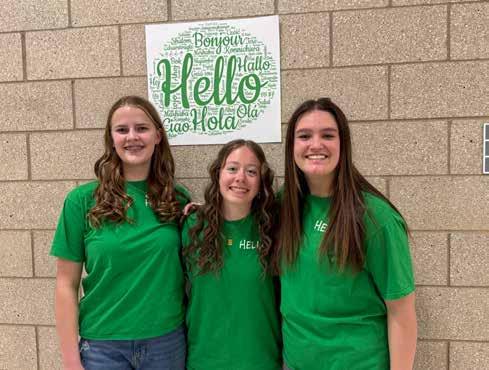
ly. The curriculum also talks about anti-bullying, empathy and compassion.”
Besides social isolation, the girls said signs such as sleep deprivation, refusal to eat, absenteeism and speaking negatively about oneself prompt them to reach out to classmates in need.
They’ve learned one of the key lessons of the Say Something Squad — reaching out to trusted adults when they notice signs of someone struggling; whether it’s joking about suicide or withdrawing from friends, speaking up could save a life, Madison said.
Eliza said teachers display posters in their classrooms to let students know they’ve been trained to help. The squad also encourages peers to turn to other trusted adults, such as parents or coaches.
The girls encourage students to use
the SafeUT app — a crisis chat and tip line which connects users with real-time crisis intervention for students, parents, educators and others — or call or text the 988 suicide and crisis hotline number.
“The important thing is to find someone,” Madison said. “In Utah, suicides are higher than it should be, especially our age. March, which is why we just had our mental health week, is the month that has the highest suicide attempts. We learned in our assembly that’s when most people are feeling lonely, sad and depressed.”
Eliza said mental health awareness is critical.
“We need to talk about suicide prevention, so people aren't afraid of it, because if
By Peri Kinder | peri.k@thecityjournals.com
Thousands of Utahns suffer in silence, struggling with anxiety, depression, stress or burnout. Societal or self-imposed barriers often stop them from getting help but by shining a light on mental health challenges, more people might be open to taking the first step toward change.
May’s Mental Health Awareness campaign is meant to inspire crucial conversations, break down stigmas and challenge misconceptions. Psychologist Magenta Silberman, Ph.D., works in Young Adult Comprehensive Assessment and Treatment at Huntsman Mental Health Institute (501 Chipeta Way). She said issues like anxiety and depression are more prevalent than people realize.
“Mental diagnoses and psychiatric conditions don’t discriminate,” she said. “Regardless of your age, gender, socioeconomic class, ethnicity, etc., you can be impacted and some are impacted in disproportionate ways. I think there is this misperception that it only happens to a select few but there’s a spectrum of what psychiatric symptoms can look like.”
Signs vary by individual but withdrawing from friends and family, having no interest in favorite activities, changes in sleep patterns, low energy or thoughts about self-harm are all examples of potential mental health illness.
Silberman said social media has changed the perception of mental health. On the plus side, people on social platforms might relate to someone going through depression and decide to get help themselves. On the other hand, sites that promote the
Continued from front page
anyone is struggling, you don't want them to be too scared to talk about it,” she said.
Jada said they want to break the stigma which comes with talking about mental health.
“In the past, if you had a mental illness, you were considered crazy and that's why they didn’t tell anybody. At the assembly, we let them know it’s normal and they're not crazy. They can talk to somebody,” she said.
Madison agrees, pointing to the need to shift people’s perception.
“Suicide ideation and depression aren't talked about enough because people are afraid if they talk about it, suicide rates will go up. But it really is the opposite. If we never talk about it, it just becomes a bigger problem and we’ll never find a cure; we're never going to get better,” she said.
Jada understands what some of her classmates may be experiencing.
“I was severely depressed during seventh grade. I felt like I had no friends. There
idea that mental health is a matter of will can be detrimental and even dangerous.
“This sort of misunderstanding, at times mischaracterizing it as a lack of willpower, can create a lot of stigma,” she said. “If you had type 1 diabetes, that would be a life-changing piece of information. You have to make lifestyle changes and take medication, and you can live a fulfilling life. The same is true for individuals with more serious, persistent mental illness.”
For those worried about family members or friends, don’t hesitate to ask questions about what they are going through. Open discussions, without judgment, can be a powerful tool. Even when we think we know what’s best for a loved one, they might not be ready to ask for help. Being self-aware can also spur us to notice mental health challenges in our own lives. Silberman listed behaviors that shouldn’t be ignored.
“If you feel like you’re not living the life that you want to live…or things aren’t bringing you joy like they used to. You’re feeling on edge and anxious, you are not feeling in control. Thoughts or feelings are interfering with your friends, your job and just living the life you want to live. That's when I would definitely get support.”
Therapeutic modalities include cognitive behavioral therapy, dialectical behavior therapy, eye movement desensitization and reprocessing, mindfulness-based therapies and transcranial magnetic stimulation (TMS).
Dr. Thomas Rayner is a psychiatrist at NeuroHealth in South Jordan (10437 S. Temple Drive). He’s dedicated to finding the best treatment for his patients and said TMS has
were people around me, but I felt I was isolated in a crowd. I would go home and not want to do anything. I wouldn't eat. I just wanted to sleep. It was rough, because of my panic attacks. I was worried I wasn't good enough; I felt I had to live up to so many expectations of my parents, my family and my friends. I felt I had to be the perfect person for everyone else, and I realized later I just needed to be good enough for myself, because if you're not good enough for yourself, you can't be good enough for anybody else,” she said.
Talking to professionals and knowing she wasn’t alone helped.
“I'm going to have depression and anxiety. I'm going to have panic attacks. But that's OK because it's something I can use to become more empathetic to others. I don't want anybody to go through what I did, so I'm going to try to help everyone the best I can,” Jada said.
The club began the school year by building connections during Hello Week, fostering inclusivity through lunchtime activities, games and pledging to “say some-

been a game changer in the battle against treatment-resistant depression.
“TMS changes brain function in key areas that are implicated in major depressive disorder and other mental health conditions,” Rayner said. “The ability to effectively treat the symptoms of depression without the barriers and side effects of medication is a giant leap forward for the field of psychiatry.”
Everyday practices like eating well, drinking water, exercising, getting enough sleep and interacting with friends can help keep mental health stable. Most people experience sadness, fear or anger, but if those emotions last too long, it could be time to talk to a professional.
For those struggling with day-to-day challenges, like getting out of bed, clean-
thing.”
Then, the squad held an anti-bullying week. The girls said prior to the week, it had been common to see slap fighting, name calling, vaping and other mean things happening at the school.
Madison said they are combating bullying through small acts of kindness such as saying hi or paying a compliment.
“I feel people can be kinder. Simple things can change somebody’s whole entire perspective on their day,” she said.
Looking back on their leadership roles, Eliza said she’s glad Say Something has made an impact at the school.
“Say Something has raised a lot of awareness; people have a better understanding of what mental health is, what a person with anxiety is dealing with, or what is going through the mind of someone dealing with depression. People have become more empathetic in understanding others,” she said. “Something good did come out of something bad.”
Jada remembers when she once masked her feelings and felt alone.
ing the house or going to work, Silberman suggested taking small steps. Put away two cups, fold one towel or straighten up one corner of the room. Doing something is better than doing nothing. Creating community can also boost mental health
“We’re social beings at our core and even for those of us that are less social, having access to people gives us new ideas,” Silberman said. “We get out of our shell and rhythm of doing the same thing that we're feeling stuck in. Just leaving the house and getting outside is helpful. Natural social opportunities can be a two-for-one to be outside and have some connection.”
For more information, visit the National Alliance on Mental Illness at NAMI.org. l
“It wasn’t until that spring when we had that assembly about mental illness when I realized I needed help,” she said. “People didn’t know the warning signs and that's why it's important to raise awareness. We need to continue to talk about this.”
With more than 34,000 schools involved nationwide, Madison said students are playing a critical part in saving lives. She said since its inception, more than 700 suicides have been prevented and 18 school shootings have been averted.
Jada said tragedies happen when people who struggle don't know how to cope with it and show up at school.
“It's really a sad thing, but it happens,” she said. “We shouldn't have to grow up with it. It shouldn't be a thing, but it is. It’s our reality. It happens. It’s ours to own, to educate people, to prevent. We’re all part of it and it’s up to all of us to say something.”
Eliza added: “That’s why it’s important to deal with mental health; it might prevent future tragedies. It’s up to all of us to speak up and support each other — because every life matters.”
By Rebecca Olds | rebecca.o@thecityjournals.com
“Even in the 10 years that we've been open, I have seen such a shift, just in the social climate of our students,” said Sarah Davies, The Piano Place founder. “I love that music is making them slow down, unplug and really tap into what's going on inside of them.”
It wasn’t until later in life that Sarah Davies, founder of The Piano Place, realized how much music could do for not only her mood but for her mental health. It’s something that she now incorporates into her teaching philosophy.
Davies grew up like a lot of us in Utah, taking piano lessons that required practice outside of the actual lesson weekly, which some of us grew to resent rather than love.
After taking piano lessons for several years, she decided to quit lessons in the sixth grade, but never actually quit the piano. She said her mom “would often say, ‘Why do you want to quit piano when you're always playing?’”
“During that time, I actually felt like a shift within myself — I felt like I didn't have a creative outlet,” she said. “And so it was really crazy, because I kept turning to music and even though I wasn't in lessons, my mom said I would just still constantly be playing.”
I feel like a lot of times I would play, depending on my mood,” she continued. “If I was frustrated or feeling antsy about something, I would go and I'd play fast songs, and I'd want to get all my energy out that way, and sometimes I'd be feeling more calm and wanting to be inspired.”
Davies restarted lessons in 10th grade and with more enthusiasm than before. Every Saturday morning at 6 a.m. for the next two years, her mother would drive her 30 minutes to visit her piano teacher and play.
Her journey from that point set her in motion on a path of music where she played professionally at The Roof Restaurant in Salt Lake City on the 10th floor of the Joseph Smith Memorial Building before teaching lessons out of her house.
“As it was a good outlet for me, I don't think I was aware of what power music could play in someone's mental health, until I actually started teaching piano,” she said. “It was with my very own students that I began to see how important it is, especially for kids, to have an outlet to turn to.”
She noticed that music could be a positive influence on her students’ mental health in a world saturated with “social media and different things like that, that kids are going through a lot when it
comes to friends and socially.”
Music, the invaluable and unlikely tool
“Even in the 10 years that we've been open, I have seen such a shift, just in the social climate of our students,” she said. “I love that music is making them slow down, unplug and really tap into what's going on inside of them.”
“They've got to dig deep. They've got to learn to sit in the heart,” she said. “And I just love that music is the venue that they can explore all of those amazing things.”
With technology on the rise, Davies expressed concern about AI in addition to the tech already flooding the world.
“I don't think we want to find out what happens mentally when we don't have the influence of music in our lives, and instead, just turn it over to technology to fill in the gaps,” she said.
Music therapist of 18 years, Camille Savage, has worked with a range of ages from children to adults. She said that the type of music we choose to listen to usually has a lot to do with our emotions and our memory.
Mostly working with those with dementia, Savage said music uses a part of the brain that can stimulate memories and emotional responses from different periods in one’s life.
“Music hits the memory, the parts of the brain where the memory is,” Savage said. “Dementia patients may not be able to form a whole sentence anymore — that's a different part of the brain — but they can sing a whole song with me.”
It works the same for children, she said. For example, a mother singing to a child that makes them feel safe and secure could help the child later in life feel that same emotion when they hear that same song.
Different instruments can be different outlets depending on the needs of the student, Savage said. For instance, drumming can be a form of stress relief or an outlet for aggression, even for deaf students.
She called music “motivating” for people, even students to learn math.
“Music is definitely powerful,” Savage said. “The more that we're able to express in healthy ways, I think the healthier mentally that we can be and using it as a means of expression.”
At The Piano Place, concerts have always been a big part of building positive attributes such as confidence and resiliency.
“As a parent, there is nothing better than seeing your kid accomplish something hard, or stand up on a stage and

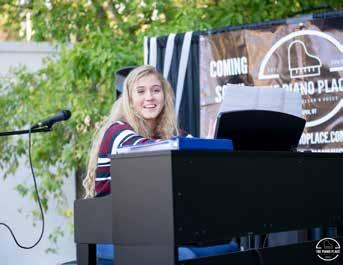
be brave,” she said. “Those moments are just absolutely priceless. And so that's one thing at The Piano Place we really emphasize.”
Davies called the ages before 12 years old as the “critical years” when laying the foundation for children to develop musical skills is the most important, with the ideal length of five years.
She said that important time is for more than just building musical talent, it’s to build resiliency and “a refuge that they can turn to and build confidence.”
In 2016, The Piano Place was built on the “core of the mission is to just figure out a way to make music fun enough and engaging enough that kids will want to stick with it.”
“For us, we are trying to help families recognize the importance of investing in a music education,” she said. “We get that it's not easy, we get that it's hard, but it is so valuable for these kids.”
The Piano Place has 12 locations in Utah and is part of a larger parent company, One Music Schools, with 12 more national locations, that employs 320 music teachers.
“Even if somebody doesn't know how to play an instrument, I think it would be important to be able to spend some time in looking over at the things that we listen to, the concerts that we go to, and really be aware of how that all does affect us,” Savage said.
By Rachel Aubrey | r.aubrey@mycityjournals.com
In November 2023, The Wellness Farm Foundation officially opened its doors as a nonprofit organization that helps “provide support for grief and trauma...” in Utah.
Much like the reconditioning of the property itself, the 2.5-acre retreat in Bluffdale has paralleled the emotional and mental reconditioning for licensed clinical social worker and founder Camille Hawkins who experienced her own loss and grief five years prior.
Hawkins and her husband currently fund the operations of the farm from their own pocket and rely on a staff of volunteers to help facilitate the monthly retreats and weekly workshops, geared towards adult participants. The retreats and workshops focus on a range of topics that are often associated with grief and trauma including divorce, suicide, substance abuse, infertility, and loss due to death or non-death experiences, in addition to parenting support.
The Wellness Farm, “intentionally create(s) a space where humans, nature and animals come together with the goal of fostering safety, connection, restoration, and empowerment.” Participants therefore are encouraged to look toward the farm’s two- and four-legged creatures as a mode of support. A mini horse, an emu, a mini donkey, bunnies, cats, goats, a pig, and a blind dog named Ray all live on the property and are available to help participants in their healing.
“What we're trying to do here is like... bring the realness,” Hawkins said.
Much, if not all of what happens on the farm is evidence-based as outlined in the volunteer facilitator training handout.
“Like with death grief, we've sort of changed the terminology to not get over your grief, but learn [and] grow with it,” Hawkins said.
Hawkins has had the experience and training to approach grief and trauma in terms of biology, taking into consideration the way certain chemicals and hormones made in the brain can lead to happiness. However, she knows well that connection is another vital means of healing.
“In order for us to go through something hard and then integrate it so that we can be happy and well-adjusted and live life, we need the right kind of support,” Hawkins said.
Originally from Davis County, Hawkins, who was interested in medicine and psychology, earned her undergraduate degree in social work from Utah State University. She spent time shadowing a medical social worker in the Intermountain Health McKay-Dee Hospital in Ogden. Her first position was on the obstetrics floor, in
the neonatal intensive care unit.
“I really enjoyed the populations I worked with,” Hawkins said. “But I did actually struggle with being in the hospital setting.”
During her time at USU, Hawkins met her future husband Palmer, an engineering major, and the two were married in 2009.
Several years into their marriage, the couple began to realize that they were unable to grow their family and struggled with infertility. Despite her personal trauma, Hawkins started a support group for those experiencing the same things as she and her husband were, which subsequently led her to founding the Utah Infertility Resource Center in 2015 where she served as the executive director for three years.
After unsuccessful attempts with in vitro fertilization, the couple turned their attention toward adoption. Present for the births of both of her daughters, currently 9 and 10, life had, at that point, seemed good.
In 2018, the same year her daughters turned 3 and 4, Hawkins found out she was pregnant.
“We were shocked,” Hawkins said. “And you know, sure enough, it was the real deal. There was a baby growing.”
Hawkins’ joy was suddenly overshadowed by loss as she birthed her stillborn daughter Everly in November 2018.
“That was tragic and heartbreaking, and I was in the hospital,” Hawkins said. “And I was like, this is so odd, because I am usually on the helping side.”
In anticipation of being home with her newborn Hawkins had already stepped down from her position with Utah Infertility Resource Center. A blessing and a curse according to Hawkins, not having to go back to work after losing her child allowed her the downtime she needed to navigate that first hard year.
“And so, you know, I just started to think, Ok, well, what do I want to do?” Hawkins said. “I had all this love for my baby, and she's not here, so I needed that energy to go somewhere.”
Still on her own journey to healing, she started her private counseling practice. Her first client was a woman who had lost a baby 20 years prior due to sudden infant death syndrome and subsequently became addicted to substances to deal with the grief.
Looking back on that period of her life, it wasn’t clear how she would help others work through their grief as she still reconciled her own.
“For me, at that time when my baby's heart stopped beating, I was like, how is my heart continuing to beat? Because I feel dead inside, and I want to be dead,”

Hawkins said.
Like a scar from a bad wound, grief never goes away, but it will heal eventually.
Voices of trauma
Healing comes at various times for various reasons. Volunteer Jamie Sheranian has worked through her grief and trauma for many years after losing both her parents to drug overdose, her father when she was 3 and her mother when she was 19. As she mourned and grieved the loss of her parents, the notion of why people feel such a heavy emotion was made clear to her.
“We grieve because we love,” Sheranian said.
Formally diagnosed with post-traumatic stress disorder, Sheranian found community at the Wellness Farm and like-
minded people dealing with similar trauma.
“Even just like a couple months ago when I first came here, I feel like I've broken out of my shell even a little bit,” Sheranian said.
Both Hawkins and Sheranian invite those who are in doubt to experience what the farm has to offer for themselves.
“Until you experience it yourself, you're not going to understand,” Sheranian said. “Or even if you're not experiencing grief or trauma, these tools are things that we can use throughout our whole entire life, not just when grieving someone.”or those looking to give back and volunteer, donate, or those interested in retreats or workshops, visit the wellnessfarmut.org.
By Cassie Goff | cassie.g@thecityjournals.com
All passengers traveling through Salt Lake International Airport will now have the opportunity to step away from the noise, stress and crowds that come along with the hustle and bustle of traveling. The Salt Lake Department of Airports’ (SLCDA) first ever Sensory Room was unveiled March 3.
The Sensory Room is “the first sensory inclusive space at the airport to offer a positive experience for all passengers with a sensory issue,” said Nancy Volmer, director of communication and marketing for Salt Lake City International Airport.
Located in Concourse A (Gate A25; adjacent to White Horse restaurant), the Sensory Room includes ADA seating, bean bags, visual light panels, air walls and activity panels.
“We want our airport to be accessible to everyone,” said Salt Lake City Mayor Erin Mendenhall. “Even in an airport as beautiful as Salt Lake City's, traveling can be noisy, crowded and stressful.”
SLCDA worked with KultureCity to design the Sensory Room with a team of medical professionals and neurodivergent individuals. As an inclusive space, the Sensory Room is intended to provide a secluded area for all passengers who may feel overwhelmed in the environment.
“One in four of us have a sensory need,” said Uma Srivastava, executive director. “For those individuals, traveling be-
comes stressful and overwhelming.”
Sensory regulation sensitives are common challenges for passengers experiencing autism, dementia and similar conditions. Sound sensitives are especially common for veterans and others who live with PTSD, older folks and young children.
“Sometimes, it may be difficult to regulate external sounds with internal feelings,” said Meg Raby, KultureCity’s sensory trainer.
In addition to the Sensory Room, the SLC Airport staff will be continually training on how to recognize and handle overload situations. They will be stocking items to be made available for passengers who may feel overwhelmed by the environment and/or experience sensory sensitivities or challenges including noise-canceling headphones, sensory bags, fidget toys, verbal cue cards and weighted lap pads.
“The new airport has been designed to be adaptable and to accommodate people of all abilities and we continue to make improvements to achieve this goal,” said Bill Wyatt, executive director of SLCDA.
Even though the Sensory Room was designed for passengers with sensory regulation challenges in mind, all passengers are encouraged to utilize the quieter environment when desired. As Salt Lake City International Airport set a new record for passengers on March 2 (37,141), thousands of individuals are expected to visit the Sen-


sory Room.
“We get to experience this moment with millions of people traveling with sensory challenges and needs,” Mendenhall said.
SLCDA plans to have three Sensory Rooms in the airport total as two additional rooms are continuing to be designed and remodeled. This is part of their mission to ensure a safe and smooth travel experience for all passengers.
KultureCity’s mission is to improve the
lives of individuals with invisible disabilities by creating sensory-inclusive spaces. They have previously helped to develop Sensory Rooms in The Park City Library, Delta Center, Caesars Superdome & Smoothie King Center in New Orleans and Audi Field in D.C. Sensory Rooms have also been constructed in the Atlanta, Portland and San Francisco airports.

As part of the city’s 20th anniversary celebrations, Cottonwood Heights has big plans through varying events to celebrate the beginning of spring and Arbor Day.
By Cassie Goff c.goff@mycityjournals.com
Continuing celebrations for the city of Cottonwood Heights 20th birthday this year (being incorporated on Jan. 14, 2005), the city council recognized Arbor Day as the first Proclamation of 2025. This follows a handful of spring time traditions for the city.
Proclamation 2025-01: Celebrating Arbor Day was recognized and dated by the city council April 1 during their council meeting at 7 p.m. Councilmember Suzanne Hyland read the proclamation. Residents of Cottonwood Heights were encouraged to celebrate Arbor Day on April 25, for the 20th year in a row.
“In 1872, J. Sterling Morton proposed to the Nebraska Board of Agriculture that a special day be set aside for the planting of trees.” The first observed Arbor Day resulted “with the planting of more than a million trees in Nebraska.”
“To celebrate Arbor Day 2025, the city
council…desires to express its support for… the related activities…including a community tree sale event and planting of any surplus trees on city property.”
The council and staff are excited to “plant trees to gladden the heart and promote the well-being of the city’s current and future residents.”
This year, Cottonwood Heights continued a newer tradition with the recurrence of the Community Tree Sale, making it the second annual Sapling Sale after a successful event last year. Saplings were purchased at a discounted price from a local gardener ahead of time and then sold to residents at cost.
City residents were able to pre-order and pick up a youngster tree from city hall (2277 Bengal Blvd.) April 26. Sapling choices included flowering pear trees, silver linden trees, Princess Diana serviceberry trees and crimson sunset maple trees.
Whitmore Library, just finishing its 50th birthday celebrations, joins Cottonwood Heights in the Arbor Day and spring time celebrations with their Seed Library.
Visitors to Whitmore (2197 Fort Union Blvd.) can utilize the seed library just like any book library. Seeds can be picked up, taken home, planted and grown into vegetables, herbs, fruits and flowers. When it’s time to harvest the seeds closer to fall, return them so the next person can check them out
The three mini workshops showcased the healing power of art.
By Cassie Goff c.goff@mycityjournals.com
creativity within the brain has been prioritized as a form of self-care in the recent years of well-being research and conversation. The Cottonwood Heights Arts Council introduced varying forms of art therapy to Utah residents during their Therapeutic Arts night April 25. Art, even as a therapy form, can continue to be practiced during Mental Health Month this May.
Therapeutic Arts Night consisted of three mini workshops focusing on art practices that center and form around well-being concepts. A consistent theme throughout the night was the healing power of creativity.
“Through art, ritual and our deep connection to nature, I guide others in reclaiming their wholeness and honoring who they truly are,” said artist and herbalist Brianna Christie.
Christie led participants through the artistic practice of pressing flowers and rearranging them into a new composition. She encourages artists to blend their artistic expression with the calming essence of the nature they were working with.
“Flowers and plants are more than just
next year.
“We want people to be thinking about harvesting seeds for this to be a self-sustaining project,” said Branch Manager Maggie Mills on April 1.
Radish, squash, lettuce, pea, tomato and more miscellaneous seeds are available free of charge at supporting Salt Lake County Library branches, while supplies last.
Continuing one more annual tradition, Cottonwood Heights has partnered with Utah Rivers Council to offer discounted rain barrels to local residents as part of their Rain Harvest program. Rain barrels allow for rain water to be harvested at home, which is legal in Utah, to help reduce demand on municipal water systems.
Residents can order their rain barrels for $57 through the Rain Water Solutions website. Address verification will be required to receive the discount. After purchase, rain barrels will need to be picked up on Saturday, May 10.
To read our previous coverage of the Cottonwood Heights 20th birthday celebrations, visit the “Recapping 20 years of Cottonwood Heights history” story in the February edition of the City Journal. This, and our other stories, can also be accessed by visiting our website at: www.cottonwoodheightsjournal.com. l

beautiful — they are living bridges to spirit, energy and healing. They support our mind, body and soul, reminding us of the magic that blooms when we allow ourselves to fully be,” Christie said. “My work blends beauty and spirituality to help people connect with their highest selves and step into the life they truly desire.”
Susan McFarlane, certified Zentangle instructor, focused on mediation for her mini-workshop. Zentangle is a structured meditative practice that utilizing drawing as a way to enhance focus and mindfulness.
Chantal Papillion guided participants through Qigong movements as Jen Cottom paired those movements with sound baths. The pairing was intended to promote inner peace through relaxation and balance.
Registration for the Arts Councils Therapeutic Arts Night began in early March and required a fee of $15. The three mini workshops ran from 6:30 p.m. until 8:30 p.m. at Cottonwood Heights City Hall (2277 Bengal Blvd.).
To learn more about the Cottonwood Heights Arts Council, visit their website at: www.cottonwoodheights.utah.gov/community/arts/arts-council
Or follow their social media pages on: Facebook at @CHArtsCouncil or Instagram at @CHCityArts.

New e-scooter and e-bike regulations from city include age limits and speed requirements.
By Cassie Goff c.goff@mycityjournals.com
e
-scooters and e-bikes will now be subject to new regulations within the city boundaries of Cottonwood Heights. This comes after months of regular and detailed conversation between the Cottonwood Heights Police Department (CHPD) and Cottonwood Heights City Council (see “city council considers possible e-transportation regulations” in the February edition of the City Journals).
One of the biggest rules to note within the new code: e-scooters are prohibited from traveling about 35 mph throughout the entire city.
“Kids need to get to soccer practice if they don’t have a car,” said Councilmember Suzanne Hyland.
The Cottonwood Heights City written ordinance now mandates e-scooter operators must be of at least 8 years of age. Riders under the age of 21 need to wear protective headgear. Riders over the age of 21 are strongly recommended to wear protective headgear as well.
In addition, e-scooter operators must keep both hands in control of operating the device at all times which means cellphone usage is prohibited (along with carrying packages or other bundles).
Councilmember Ellen Birrell appreciates that the council is giving more consideration to e-transportation alternatives “contrasting with the average cost of owning a vehicle in the U.S. is $10,000 per year.”
Birrell recounted a recent conversation with a Midvale resident who commutes to work in Cottonwood Heights via e-scooter, because he can’t afford a car. He got in an accident along Fort Union Boulevard because a pedestrian stepped out from behind a utility pole and he had to swerve on his e-scooter going around 15 mph. He did break his

forearm but was thankful he didn’t hit that pedestrian especially because the recently passed ordinance does specify that e-scooters must yield to pedestrians in all circumstances. In addition, e-scooters should yield to bicycles in the right-of-ways.
“This ordinance is a great starting place,” Hyland said.
She hopes the legislature will consider a statewide ordinance for e-bikes but if they won’t consider that then she’s comfortable expanding on the current ordinance written with e-scooters in mind to involve e-bikes more specifically.
Some of the additional newly written rules for e-scooters include: ensuring parking of e-scooters is permitted and doesn’t impede traffic; ensuring all e-scooters are equipped with a working bell or other sound mechanism (just not a siren or whistle); and e-scooters cannot be operated at night without the proper lighting equipment.
In response to the new city regulations for e-transportation alternatives, the Cottonwood Heights Subcommittee for Active Transportation would like an education campaign to be put out to residents. They would also like to put out a public survey at the end of the fall season to get data about how these regulations are being enacted and practiced by residents.

Councilmember Shawn Newell voiced a concern about taking CHPD officers and resources away from other calls when responding and collecting data about e-transportation regulations especially if they’re being asked to compile significant data for the Active Transportation Subcommittee this first year.
Ordinance 433: Enacting Chapter 11.34 of the Cottonwood Heights Code Concerning Electric Scooters was motioned by Newell, seconded by Hyland, and unanimously approved March 4.
Oh! and don’t forget – you can still get a DUI if riding/operating e-scooters and e-bikes while intoxicated. l








Brighton qualified a decade-high 14 wrestlers for state with five state placers.
By Jerry S. Christensen j.christensen@mycityjournals.com
Wrestling is a sport with few glory moments. It is a grueling season of daily workouts and increasing levels of competition. “We work hard because we know our competition is in their wrestling room working just as hard,” said three-year Brighton head coach Burke Gappmayer who acquired his wrestling workout ethic at Wasatch High alongside fellow teammate Cael Sanderson.
Those painful months/years of preparation paid off for Brighton’s wrestling program as 14 wrestlers qualified for the 2025 5A state tournament. Four of those state-qualifying wrestlers pushed it up a notch and ended the season on the state podium as state placers. It was a moment of wrestling glory.
The wrestling season at Brighton began with a disquieting event. Senior Ben Tillman, a returning state wrestler who in October qualified as an All American at Rocky Mountain Nationals in Las Vegas, tore his meniscus in the first match of the season at Riverton. That
career-ending mishap forced other wrestlers to step up and assume the varsity role. Tillman continued to show leadership from the sidelines throughout the season and was mat side at every state bout.
Brighton wrestlers who qualified for state are: Ethan Wadley, Sumisi Uai, George Spencer, Jaron Gappmayer, Landon Hill, Trevor Mann, Fernando Cortez, Manoa Herb, Elise Lewis, Mei Mei Engebretsen, Cara Garff, Lily Bake, Kimeeya Hashimi and Elsie Sullivan.
Mann, a sophomore, said, “Being a state wrestler means a lot to me, and it proves that I am capable of achieving any goal that I set my mind to. Being a state wrestler shows me that I have grown as a wrestler and how far I’ve come in my journey. It also shows that all the hard work I put in the wrestling room and all the early mornings paid off and it didn’t go to waste. I felt like it was a great way to end off the season and I can’t wait to do even better next year.”
The 5A State Wrestling
The Big Stage at Utah Valley University is the pinnacle of the wrestling year. Just to be qualified to be among the 16 wrestlers at each weight is an honor. It is a testament to tenacity and resolve. To stand on the podium at the end of the two-day state tournament denotes
distinction.
Engebretsen, a junior at 120 pounds, took the next step by becoming a 2025 state finalist placing second. She took third in 2024. Hill, a multisport junior at 144 pounds, took third place. Cortez, a junior at 190 pounds, took sixth place. Herb, a junior at 170 pounds, took sixth place.
“Felt great to accomplish one of my biggest goals this season. But the road doesn’t end here. I have bigger dreams and aspirations for next year,” Hill said.
“I love how our wrestlers stepped up through tough tournaments that prepared us for state. To qualify so many wrestlers for state and bring the program to top 10 status bodes well for next year. We continue to work, evolve and innovate as a team,” girls head coach Joidee Gappmayer said.
Postseason tournaments in Denver and Bull Head, Arizona produced more club hardware where Engebretsen, Cannon Bake, Hill and Lily Bake took first place trophies. Cortez took second, Jarom Gappmayer took fourth and Sullivan took fourth.
Coach Burke Gappmayer competed in jiu jitsu and took first place much to the delight of the Brighton student-athletes. l
Brighton boys tennis is back in the state mix after taking state in 2023 and narrowly missing a repeat state championship in 2024.
By Jerry S. Christensen j.christensen@mycityjournals.com
The Brighton High girls and boys tennis program has earned 28 state championship teams in the school’s storied history. That figure is even more impressive given the number of runner-up trophies that also adorn Brighton’s Hall of Champions.
The current Brighton boys tennis program is building on that winning tradition with a state championship in 2023 and a narrow, one-point loss to Highland in 2024 to take second place. After the last two years of finals appearances, the varsity graduated five of its seven position players. In Brighton tennis tradition, the “next up” student-athletes stepped up and put in the work to move into those spots.
Current varsity contenders include Henry Owen at No. 1 singles, Davis Cook at No. 2 singles, Nigel Mansell and Matthew Huber alternating No. 3 singles, Max Pohlman and Ollie Hopkin at No. 1 doubles and Argo Tarr and Owen Maxfield at No. 2 doubles.
The Brighton tennis winning tradition has been safeguarded by head coach Natalie Meyer who began playing for Brighton 41 years ago (winning three state titles) and now is coaching in her 22nd year. Because she coaches both boys and girls tennis, that is the equivalent of coaching 44 seasons. She also teaches math at her alma mater. Meyer said her goal is “to provide as many young players as possible the opportunity to learn a sport for a lifetime, develop relationships with their peers and community, have fun, and learn life skills that will help them to be successful


adults.”
Meyer was honored this year as a National Coach of the Year for girls athletics. This elite designation by the National Federation of State High School Associations is awarded to 10 coaches of all sports across United States.
Brighton principal Marielle Rawle said, “I couldn’t be more proud of coach Meyer! Being named one of the top coaches in the country—along with State and Sectional
Coach of the Year—is an incredible accomplishment. She has made a huge impact not only on our tennis program, but across the school and community. This award is a reflection of the way she coaches with both heart and purpose. Well-deserved!”
A new tradition emerges
The boys tennis team chose to put a rose on their uniforms this year to play in honor of coach Meyer’s mother Roseanne Newell who passed away last November. Newell was on the Utah Tennis Board for many years. She brought tennis programs to elementary school students at the schools where she taught and where she was school principal. She volunteered for years for the Brighton tennis teams taking scores at matches, running region tournaments, and running the first rounds of all the classifications state tournaments held at Brighton. She was an integral part of Brighton’s long tennis tradition of excellence.
“After my mom passed away, I decided to create a spring slam after her. I will now put her name on the fall slam as well. We plan on holding these annually for the boys and girls seasons,” Meyer said. The Roseanne Newell tournaments bring teams from Southern Utah to compete in dual formats against teams from Northern Utah. The varsity teams play duals against each team at each position for two days. The team that wins the most duals wins the trophy and medals for the players. Each school also brings four JV doubles teams and they compete in a compass draw that guarantees them five matches.
The Brighton tennis teams can be seen practicing and playing on the courts just east of the high school. The playin round of the 6A state tennis tournament is hosted by Brighton on the Bengal Boulevard courts May 3. The 5A state tennis tournament continues at the Liberty Park tennis courts on May 8 and 10. l
Utah is one of five regions to receive 100 Comcast RISE small business grants.
By Peri Kinder peri.k@thecityjournals.com
Getting a small business off the ground, or scaling to the next level, takes more than hustle and passion. It takes resources. A small business grant can be the difference between success and failure, and Comcast is investing in success.
The Comcast RISE program will award comprehensive grant packages to 100 small businesses in Bluffdale, Draper, Herriman, Riverton, Sandy, South Jordan, West Jordan and White City. Through May, Comcast will accept applications from small business owners who are committed to growing their companies, lifting their communities and inspiring the next generation.
“The Comcast RISE program will deliver innovative and impactful resources that will make a lasting impact on small businesses in Utah. Supporting small businesses is crucial for economic development and ensuring that the backbone of our communities can thrive,” said J.D. Keller, senior vice president of Comcast’s Mountain West Region. “Among the many things we all love about Utah is our vibrant small businesses and Comcast’s commitment to supporting them.”
Each grant includes a technology makeover (with digital services for one year), access to online entrepreneurship courses, coaching sessions, a business assessment and $5,000. Grant recipients will also receive a professionally produced TV commercial and media strategy consultation.
Scott Cuthbertson, president/CEO of the Economic Development Corporation of Utah, said small businesses are the foundation of the state’s economy. More than 90% of companies in Utah are considered small businesses, run by families, friends and neighbors. He said it’s essential that these businesses succeed.
“Comcast is such a valued partner,” Cuthbertson said. “They make critical investments in our infrastructure and we think they’re exemplary about how they invest back into the community, in particular, through this RISE program that provides needed support to our small business owners.”
Andrea Benitez is the fundraising manager at Suazo Business Center, which offers resources for economically disadvantaged businesses. Through education, workshops, and access to capital, the center has helped launch hundreds of small businesses, generating millions of dollars
in revenue.
Benitez’s clients include minority and underserved populations who need direction for creating a business. They might not qualify for a loan or don’t want to go into debt to fund their dreams, so the Comcast RISE program could be a game changer for these struggling entrepreneurs.
“This Comcast grant is just a great opportunity for them to apply and help their business grow,” Benitez said. “We have lots of clients in that part of the valley and we’re going to help them apply for this grant.”
Diana Lopez owns Cakes by Edith, a popular bakery with two locations in the Salt Lake Valley. As a small business owner, she understands the obstacles faced by entrepreneurs and the many hats they have to wear to keep their businesses running.
As Cakes by Edith grows, Lopez hopes to expand to a third location where she can continue to carry on her family’s legacy. She said if she’s awarded the Comcast RISE grant, she’ll use the funds for marketing and equipment.
“There are so many trends in the baking industry and we’re trying to stay current with everything in the baking world,” Lopez said. “This opportunity with Comcast would provide for businesses in the area. For us, honestly, we would love that opportunity.”
The southern end of Salt Lake County has seen significant growth during the last decade and is geared for more expansion.
The South Valley Chamber of Commerce, in partnership with Salt Lake Community College, offers a 10-week entrepreneurial program to help small business owners find resources for success.
Jay Francis, president/CEO of the South Valley Chamber of Commerce, said small business owners face myriad challenges as they try to get an idea off the ground and that this Comcast RISE program could give them the momentum they need to create something big.
“If a business is fortunate enough to be able to receive one of these grants, I think that’s huge. It’s a real lift and a real boost,” Francis said. “I appreciate Comcast and I think more opportunities need to be afforded to small businesses. This fits in really well with things that we’re focusing on as a Chamber.”
Utah is one of five regions to receive 100 Comcast RISE small business grants this year. Recipients from Salt Lake, Boston, Grand Rapids, Nashville and Seattle will join the 14,000 entrepreneurs nationwide who have been supported through the program since it launched in 2020. For more information, visit www.ComcastRISE.com. l

























The annual 3-on-3 basketball games in the Canyons School District middle schools were fiercely competitive, with Albion Middle School’s team claiming victory in the boys' and girls' seventh- and eighth-grade tournaments.
“The seventh-grade boys’ final was very exciting,” said intramural tournament organizer Taylor Hansen. “Both the first-/ second-place game and third-/fourth-place game ended with a free throw shoot-off.”
In the sixth-grade girls’ tournament, Draper Park took home first place, with Butler securing second. Albion’s teams A and B competed for third and fourth, respectively.
On the sixth-grade boys’ side, it was a close contest between Butler and Indian Hills. Butler’s A team defeated Indian Hills’ B team in the championship, while Indian Hills’ A team triumphed over Butler’s B team for third place.
Albion clinched the seventh-grade girls’ championship by defeating Edgemont and Mount Jordan beat Indian Hills to win third place.
In the seventh-grade boys’ tournament, Albion’s A team claimed the title over Indian Hills’ A team, with Indian Hills’ B team taking third and Union finishing fourth.
Albion secured a win over Butler in the final of the eighth-grade girls’ competition. Draper Park finished in third place while Mt. Jordan took fourth.
Finally, in the eighth-grade boys’ championship, Albion’s A team came out on top against Indian Hills’ A team, with Butler’s A team finishing third and Albion’s B team placing fourth. l
I was born with the fashion sense of a platypus: lots of assorted parts coming
nothing you could call
It’s not that I haven’t tried to dress nice. I even did some fashion research and read an article that said I should find clothing that fits my personality to feel confident about my wardrobe. My personality is a cross between a hibernating bear and a librarian, so I guess I should wear furry blankets and mustard-colored cardigans? Done.
The article also said to implement different colors and patterns, and not to be afraid to get out of my comfort zone. But my comfort zone is so comfy. Hence the name.
For a long time, my fashion palette consisted only of black; or gray, if the occasion called for levity. Walking through the grocery store, I was often mistaken for a murder of crows, but that might have been because of all the flapping and squawking.
So, I banned black from my closet, except for 13 black blouses because you never know when you’ll attend a My Chemical Romance concert. Then I decided any new clothes I purchased couldn’t be black. Now my closet is filled with a rainbow of dark navy, charcoal, espresso and eggplant for when I’m feeling whimsical.

The article suggested trying different styles. Trendy boxy tops look adorable on the pages of fashion magazines but turned me into SpongeBob. Maybe I should stop wearing striped socks with squeaky black shoes and white laces.
I just don’t know how to look effortlessly stylish although Vogue breaks it down into 79 manageable steps. I stopped reading after the one step suggested I wear one thing that scares me. Crocs are the most frightening thing I could think of. Nope.
Once, I was working at an event and was given a T-shirt to wear. I threw on a pair of shorts and called it good. My coworker showed up in her T-shirt matched with cute capris, colorful espadrilles and a rakish beret. I felt like Gollum standing next to her.
If I have to attend any social event, I get fashion paralysis, completely incapable of choosing an outfit. If the event is really fancy, I’ll spend at least 47 days riddled
with anxiety about what to wear. My husband says, “Go buy something new,” but that makes it even worse because trying on clothes is a torture device invented during the Spanish Inquisition.
First, the options are overwhelming. Second, what if I choose something too dressy? I don’t want to look like a wedding cake if the event calls for shortbread. Third, I want my clothes to feel comfy, which is the complete opposite of style. No wonder fashion models always look so angry.
The one area in fashion that I do shine is footwear because Chuck Taylors can be worn with anything. Barefoot is also an option I employ from May through October. (By Halloween, the soles of my feet are as tough as a Kevlar and as grungy as a music festival’s porta-potty.)
Oscar Wilde, my style guru, said, “Fashion is a form of ugliness so intolerable that we have to alter it every six months.”
If every fashion trend comes back again, I’ll just stick with what I love: clothes that hide salsa stains and are super soft. Anna Wintour would have some disparaging glances to throw my way but it’s better than my platypus fashion that looks like I just crawled out of a swamp.










Dr. Hararah, a triple board-certified physician, completed his residency in Family Medicine at NYU Langone and a fellowship in Undersea and Hyperbaric Medicine/Wound Care at SUNY Upstate University Hospital. With additional training in Bariatric Medicine and certification from the American Board of Obesity Medicine, he brings expertise in primary care, dive medicine, bariatric medicine, and clinical hyperbarics. A firm believer in the biopsychosocial approach, Dr. Hararah views patients as complex individuals whose lives and experiences shape their healthcare.
Known for his compassionate care and dedication, he listens intently, prioritizes your well-being, and works to find the best diagnosis and treatment plan. As the owner of Riverstone Medical, Dr. Hararah is committed to helping you achieve your best health.
Specializing in Wound Care:
• Chronic, non-healing wounds
• Acute, minor wounds
• Diabetic foot ulcers
• Venous ulcers
• Arterial ulcers
• Pressure injuries
• ...and more!
ASK ABOUT
Primary Care:
• Annual preventative physical exams
• Cancer screening
• Sick visits
• Specialist referrals
• Medication refills
• Chronic disease management
Patients First: Dr. Hararah understands the daunting and sometimes demoralizing feelings health care sometimes causes, and wants patients to be truly seen and valued as human beings.
We'd love to see you!
Call or text to make an appointment: 801-509-9138
688 Vine St., Suite 16, Murray riverstone-medical.com


SCAN TO VISIT OUR WEBSITE




























